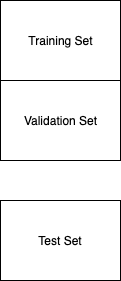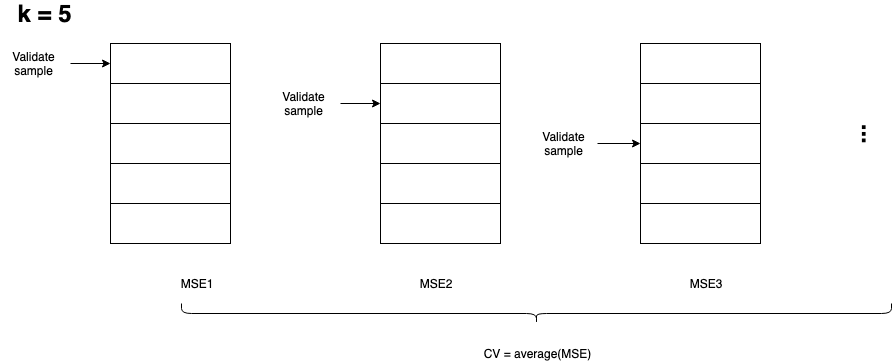Resampling ¶
Validation Set Approach¶

the error rate of validation set is used to estimate the error rate of test set¶
Cons¶
- the validation estimate of the test error rate can be highly variable. This means that when it is repeated, it gives different results, often very different results
- the validation set error rate may tend to overestimate the test error rate
Leave-One-Out Cross Validaiton (LOOCV)¶

Repeat training and validaiton n times, n is the number of samples. Each time use n-1 samples as training set and 1 sample as validation set.
Pros¶
- Far less bias, not to overestimate the test error rate
- LOOCV yield the same results, no randomness in hte training/validation set splits
Cons¶
- training sets are highly correlated, tends to have higher variance
Application¶
- LOOCV is often better than k-fold CV when the size of the dataset is small
k-fold Cross Validation¶

Dataset is randomly divided into k groups, or folds, of approximately equal size. Repeat training and validation k time, each time use k-1 folds as training set and 1 fold as validation set. k = 5 or k = 10.
Pros¶
- More accurate estimates of the test error rate than LOOCV
- Higher bias and lower variance than LOOCV, is a bias-variance trade-off
Application¶
- unless the dataset were very small, use k-fold cross-validation
CV on Regression and Classification¶
- Regression, use MSE
- Classification, use the number of misclassified observations
Bootstrap¶
- Randomly sampling, with replacement, from an original dataset for use in obtaining statistical estimates. The generated dataset is a bootstrap sample set. Use boostrap sample set as the training set.
- The unselected samples in the original dataset is a out-of-bag (OOB) sample. Use the OOB sample set as the validation set.
Application¶
- Small sample size
- Non-normal distribution of the sample
- A test of means for two samples
- Not as sensitive to N
Final Machine Learning Model¶
- Use resampling methods to choose a model which has best performance
- Applying the chosen machine learning model on all of your data
- Save the model for later or operational use.
- Make predictions on new data.